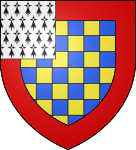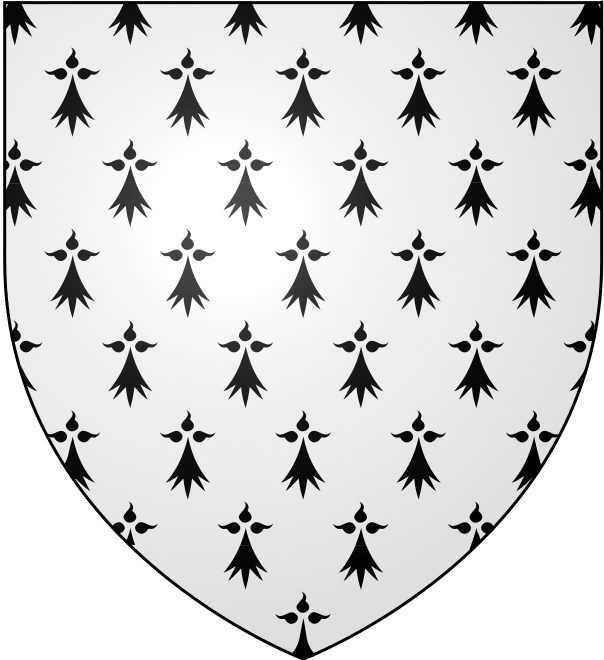Flag of Brittany
The flag of Brittany is the unofficial flag of Brittany, a region in the northwest of France. It is called the Gwenn-ha-du, pronounced [ɡwɛnaˈdyː], which means white and black in Breton. It is also unofficially used in the department of Loire-Atlantique although this now belongs to the Pays de la Loire and not to the region of Brittany, as the territory of Loire-Atlantique is historically part of the province of Brittany. Nantes (Naoned), its prefecture, was once one of the two capital cities of Brittany.
.svg.png) | |
| Use | Civil and state flag |
|---|---|
| Proportion | 2:3 |
| Design | Nine horizontal stripes alternating black and white with an ermine canton (sable, four bars argent, a canton ermine) |
| Designed by | Morvan Marchal |
The flag was created in 1923 by Morvan Marchal.
Overview
The dimensions of the flag are not fixed and may vary from 9 cm × 14 cm (3.5 in × 5.5 in) to 8 m × 12 m (26 ft × 39 ft). The flag is used not only by cultural associations or separatists but by other people. For years the authorities considered the flag as a separatist symbol, but the attitude has now changed and the flag, no longer having any political connotations, may appear everywhere, even on public buildings, along with the other official flags. It is widely used throughout Brittany and can even be seen on town halls in the region. Because of the absence of legislation concerning regional flags in France the flag is also flown on sailing boats and fishing boats. The design of the ermine spots varies but the version most frequently seen is shown above.
The flag was created in 1923 by Morvan Marchal. He used as his inspiration the flag of the United States, seen as a symbol of freedom.[1]
The nine horizontal stripes represent the traditional dioceses of Brittany into which the duchy was divided historically. The five black stripes represent the French or Gallo speaking dioceses of Dol, Nantes, Rennes, Saint-Malo and Saint-Brieuc; the four white stripes represent the Breton-speaking dioceses of Trégor, Léon, Cornouaille and Vannes. The ermine canton recalls the arms of the Duchy of Brittany.
The flag first came to the notice of a wider public at the Exposition Internationale des Arts Décoratifs et Industriels Modernes in Paris in 1925. It was adopted by various cultural and nationalist groups through the 1920s and 1930s. However its association with nationalist and separatist groups during the Second World War brought suspicions of collaboration to the flag. A revival of interest in the flag took place in the 1960s. Since then it has mostly lost an association with separatism in the mind of the public and become a widely accepted symbol for all Brittany and Bretons. The older ermine field flag and black cross continue to be used, though rarely, by some individuals and groups.
In blazons the flag is Sable, four bars Argent; the canton ermine. Traditionally coats of arms could be displayed as a rectangular banner as well as on a shield.
Gallery
 Coat of arms from 1213 onwards (Checky or and azure within a bordure gules, a canton ermine).
Coat of arms from 1213 onwards (Checky or and azure within a bordure gules, a canton ermine). Army flag and ensign (14th-16th centuries)
Army flag and ensign (14th-16th centuries)
Historically, Bretons had used a black cross on a white ground. Little information is available about this flag before the 14th century. The Kroaz Du was one of the principal Breton flags during the Middle Ages. It figured in the Combat of the Thirty, as well as the Hundred Years' War, and saw wide use by Breton sailors. It is considered by Breton royalists to be the true flag of Brittany.
The Kroaz Du was one of the principal Breton flags during the Middle Ages. It figured in the Combat of the Thirty, as well as the Hundred Years' War, and saw wide use by Breton sailors. It is considered by Breton royalists to be the true flag of Brittany. Coat of arms from 1316 onwards (semé d'hermine)
Coat of arms from 1316 onwards (semé d'hermine) Coat of arms of Rennes
Coat of arms of Rennes.svg.png) The flag of the Duchy of Brittany.
The flag of the Duchy of Brittany.
Reference source
References
- "Gwenn ha Du, the Breton cousin of the Stars and Stripes". France-Amérique.